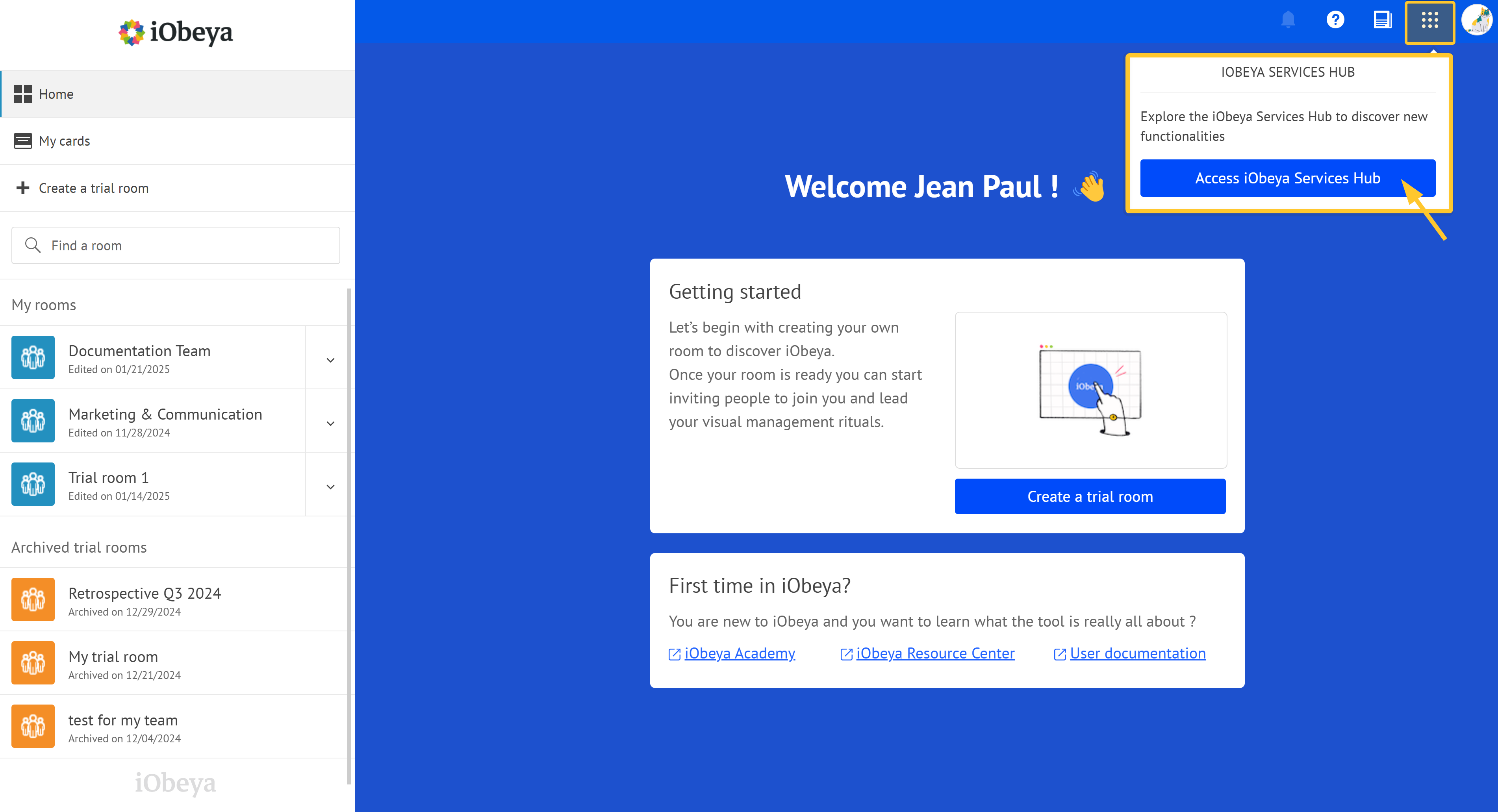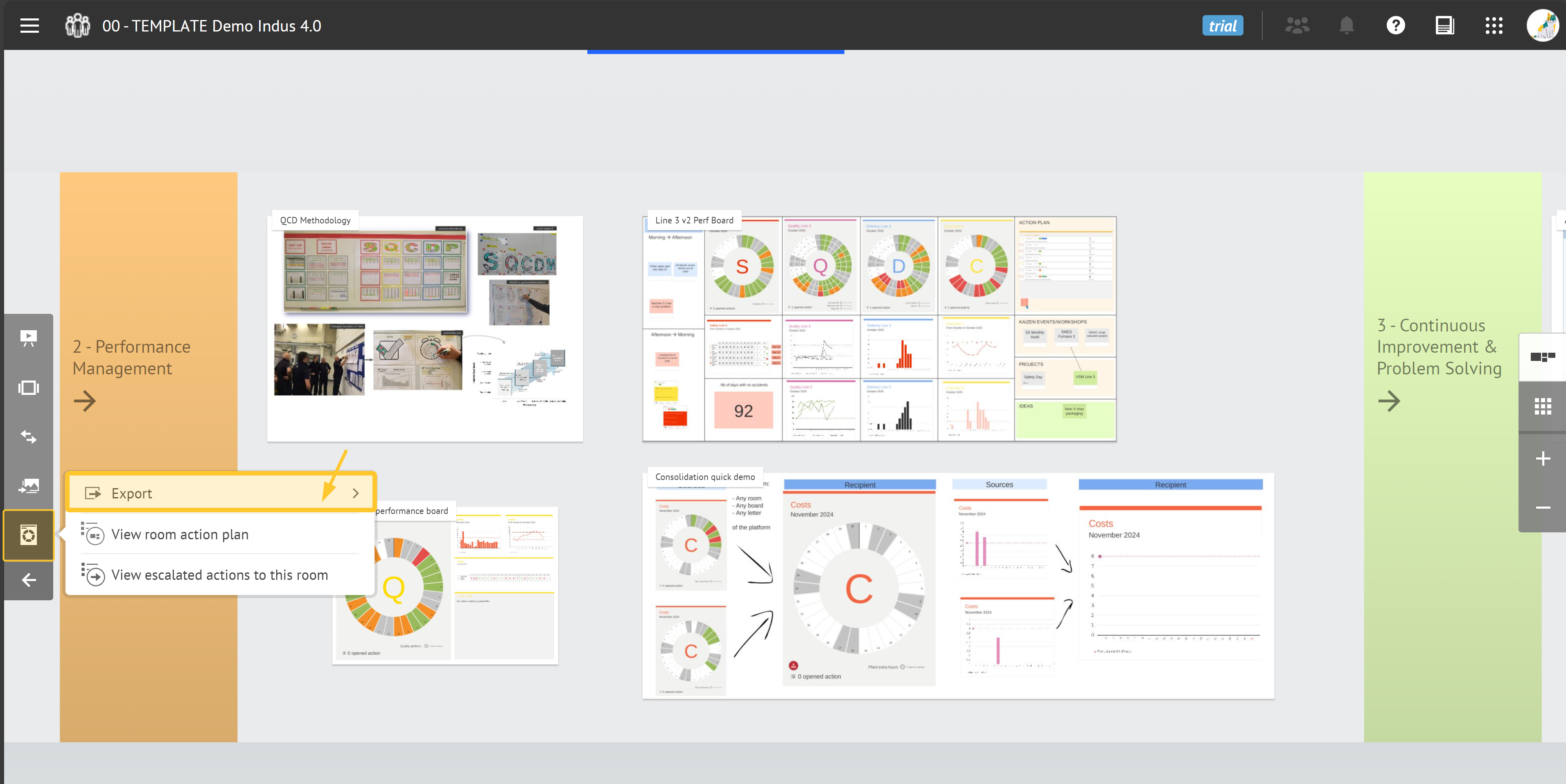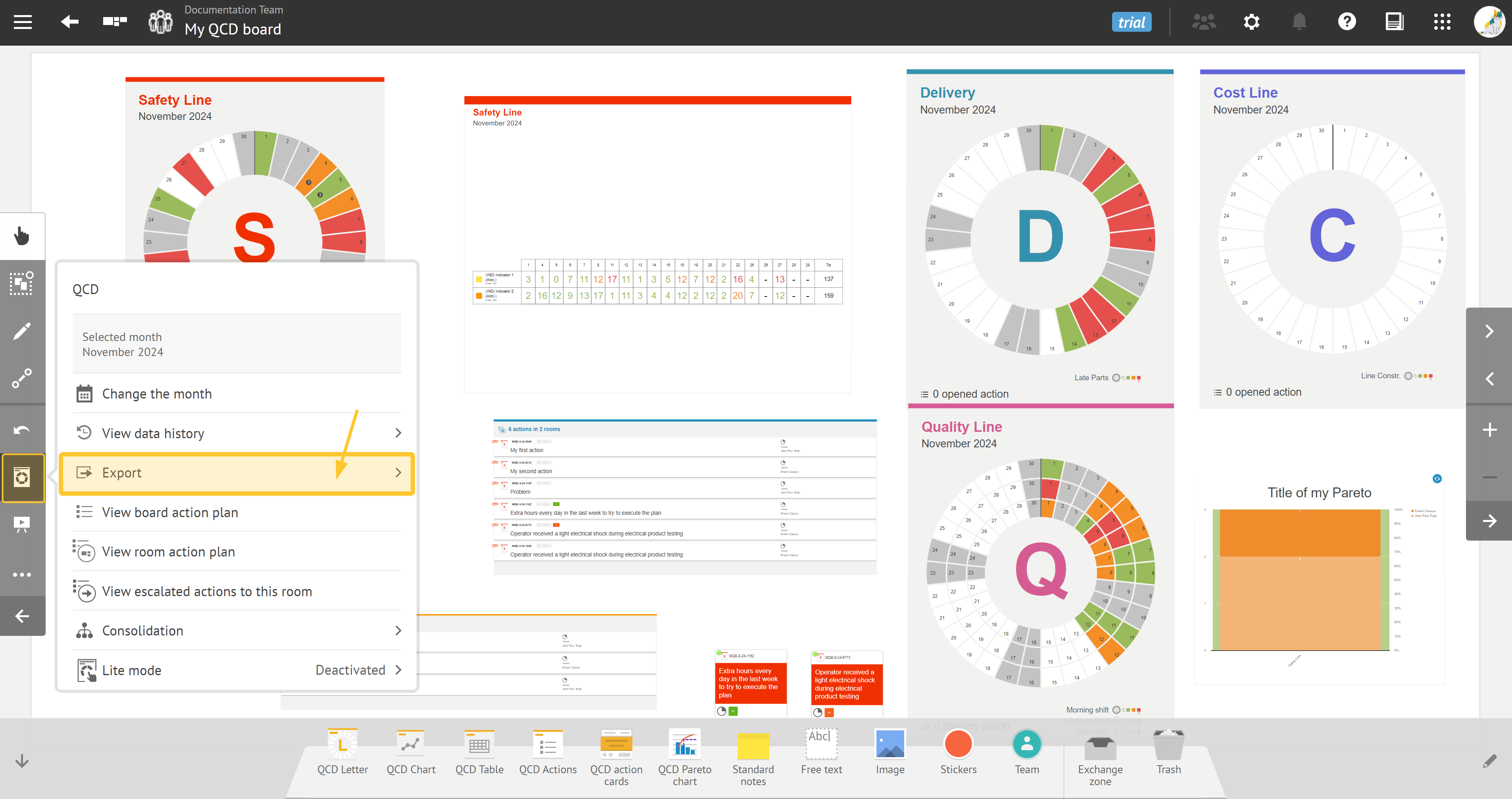Managing QCD data in iObeya relies on seamless information flow. Importing and exporting streamline action management, save time and enhance analysis.
This article explains how to use these features to optimize your QCD management. It covers how to prepare your data, import it into iObeya and export the results.
Importing Data into QCD
Warning:
Thes following procedures are documented for reference only. They are unofficial and informative.
Be sure to follow the described steps and constants carefully. Any consequences due to any non-compliant handling are not considered our responsibility.
Note:
If you import data into QCD, you need to validate the file on a test platform, room or board. iObeya does not handle any format errors or functional inconsistencies that may be found in such test environment. In addition to this, once data is imported, no roll back is possible.
To import data in a letter:
Select the letter on the board.
Export the selection using the corresponding utility.
In the .csv file, keep row 1 and the one whose value in the entityType column equals “QCDLetter” to make sure you do not touch anything else.
Edit the file.
Save the file with the exact original format of iObeya (including encoding, separators …)
After you edit the .csv file, import it using the corresponding utility.
Excel to QCD Service
The Excel to QCD service in the iObeya Services Hub allows to seamlessly import performance indicator data from Excel or CSV files into QCD Letters.

You can upload Excel or CSV files populated with performance indicators to input data directly into QCD Letters. This service supports simple use cases as well as more advanced configurations, including QCD Letters containing multiple rings and indicators.
The file format and required fields are described in detail in an article directly available on the service’s page or here so that you can prepare your data correctly before attempting to import.
Importing Actions
By default, the actions are linked to the outer ring.
We recommend to create actions in the current time window. You can retrieve this time window ID by exporting a letter with the value of its props.currentHistoricalCuid property.
Column name | Description | Example value |
|---|---|---|
class | Sets element type, it is mandatory to be this value | class com.iobeya.entity.FlexibleBoardElementChild |
element | Determines to which BoardElement the action relates to. So in the example, B611F896-EC9D-4030-BD68-F170FB96FE53 is the unique ID of the letter to which the action is associated. | <com.iobeya.entity.Note;B611F896-EC9D-4030-BD68-F170FB96FE53> |
entityType | Sets entity type, it is mandatory to be this value | QCDLetterAction |
props.author | Author’s name | ad min |
props.authorUsername | Author’s username | ad min |
props.cause | Text of the cause | La cause |
props.creationDate | Action creation date in milliseconds | 1524572630788 |
props.criticality | Criticality value (0 none, 1 trivial, 2 minor, 3 major, 4 critical, 5 blocking) | 2 |
props.dueDate | Due date in milliseconds | 1524088800000 |
props.historicalCuid | Unique Id of the history to which the action is attached | 5bfede29-af76-4e5b-adb6-a1026f84d1a3 |
props.isInnerCircle | Determines whether the action is in the inner ring (can only be true if isMiddleCircle is false) | false |
props.isMiddleCircle | Determines whether the action is in the “central” ring (can only be true if isInnerCircle is false) | false |
props.letter | Letter of the letter | C |
props.owner | Owner’s namer | Owner |
props.ownerUsername | Owner’s username | Owner |
props.priority | Priority value (0 or empty, 1, 2, 3) | 2 |
props.problem | Problem description | problem |
props.solution | Solution description | solution |
props.status | Action status (1, 2, 3, 4) | 3 |
props.wedgeNumber | The box number the action is linked to in a given defined ring. This number must not be greater than the number of occurrences of the array represented by the wedgesLabel property of the letter. | 4 |
Importing Letters - moving from 1 to 2 or 3 Rings
Warning:
When you import a letter, the actions and action cards attached to this letter are deleted.
Action cards that are not attached to the letter are kept.
Column name | Description | Example value |
|---|---|---|
props.ritualFrequencyMiddleCircle | Enter the numerical value of the desired ritual frequency (see values below.) | 2 |
props.wedgesLabelMiddleCircle | Enter the labels of the boxes as a table (see values below.) | [« 1 », « 2 », « 3 », « 4 », « 5 », « 6 », « 7 », « 8 », « 9 », « 10 », « 11 », « 12 », « 13 », « 14 », « 15 », « 16 », « 17 », « 18 », « 19 », « 20 », « 21 », « 22 », « 23 », « 24 », « 25 », « 26 », « 27 », « 28 », « 29 », « 30 », « 31 »] |
Values
Half-yearly ritual:
ritualFrequency : 2
wedgesLabel : [« 1 », « 2 », « 3 », « 4 », « 5 », « 6 », « 7 », « 8 », « 9 », « 10 », « 11 », « 12 », « 13 », « 14 », « 15 », « 16 », « 17 », « 18 », « 19 », « 20 », « 21 », « 22 », « 23 », « 24 », « 25 », « 26 », « 27 », « 28 », « 29 », « 30 », « 31 »]
Quaterly ritual:
ritualFrequency : 4
wedgesLabel : [« 1 », « 2 », « 3 », « 4 », « 5 », « 6 », « 7 », « 8 », « 9 », « 10 », « 11 », « 12 », « 13 », « 14 », « 15 », « 16 », « 17 », « 18 », « 19 », « 20 », « 21 », « 22 », « 23 », « 24 », « 25 », « 26 », « 27 », « 28 », « 29 », « 30 », « 31 »]
Monthly ritual:
ritualFrequency : 1
wedgesLabel : [« 1 », « 2 », « 3 », « 4 », « 5 », « 6 », « 7 », « 8 », « 9 », « 10 », « 11 », « 12 »]
Weekly ritual:
ritualFrequency : 5
wedgesLabel : [« 1 », « 2 », « 3 », « 4 », « 5 », « 6 », « 7 », « 8 », « 9 », « 10 », « 11 », « 12 », « 13 », « 14 », « 15 », « 16 », « 17 », « 18 », « 19 », « 20 », « 21 », « 22 », « 23 », « 24 », « 25 », « 26 », « 27 », « 28 », « 29 », « 30 », « 31 », « 32 », « 33 », « 34 », « 35 », « 36 », « 37 », « 38 », « 39 », « 40 », « 41 », « 42 », « 43 », « 44 », « 45 », « 46 », « 47 », « 48 », « 49 », « 50 », « 51 », « 52 », « 53 »]
Daily ritual:
ritualFrequency : 31
wedgesLabel : [« 1 », « 2 », « 3 », « 4 », « 5 », « 6 », « 7 », « 8 », « 9 », « 10 », « 11 », « 12 », « 13 », « 14 », « 15 », « 16 », « 17 », « 18 », « 19 », « 20 », « 21 », « 22 », « 23 », « 24 », « 25 », « 26 », « 27 », « 28 », « 29 », « 30 », « 31 »]
Note:
If it is necessary to add a third ring, do the same as in points 4 and 5 replacing in the names of properties “Middle” by “Inner”
Importing Elements
To import/export elements, see Importing data of Getting Started with iObeya user guide.
If you import an element in the same board from which you made an export, all elements on the board (letters, actions with card, indicators, etc) are updated, except for actions without cards.
If you import elements to another board, only the letter is imported.
Importing Boards
To import/export a board, see Importing/exporting data of Getting Started with iObeya user guide.
If you import a board, every element on the board (letters, actions, indicators, etc) are imported identically.
Note:
From the same room, when you import a board from which you made the export, if an action is modified on the original board before the import, the action is imported with the new information.
Importing Rooms
You perform the import/export of a room from the administrator platform. See Importing and exporting a room of the Administration guide to find out more.
If you import a room, every element (board, letters, actions, indicators, etc) are imported identically.
Warning:
You need to the necessary rights to perform these actions.
Exporting QCD Data
To export QCD data, access the data export utility at:
A room level:

Export letters: allows to create an archive file per letter.
Export actions: allows to create an archive file for all the actions present on the boards in your room.
A board level:

Export letters: allows to create an archive file for each letter present on the board.
Export actions: allows to create an archive file for all the actions declared across all the letters on the board.
Note:
The exported files are in .csv format.
Structure of Actions Export
One line per action belonging to a letter on a given board.
Column name | Description |
|---|---|
Room_name | Name of the room the action belongs to |
Board_name | Name of the board |
Letter | Name of the letter the action belongs to (name of the tool) |
Action_ID | Action ID |
Creation_date | Date of action creation |
Modification_date | Date of action modification |
Board_duration_type | Board frequency type |
Period | Time window |
Wedge | Name of the box the action belongs to |
Problem | Action problem |
Problem_criticity | Problem criticality |
Category | Problem category |
Cause | Cause |
Author | Author |
Owner | Owner |
Solution | Solution |
Due_date | Due date |
Status | Status |
Priority | Priority (from 0 to 3) |
KPI | Indicator names, separated by a comma |
Escalation_level | Escalation level |
Escalation_reason | Reason for escalation |
Escalation_answer | Answer to escalation |
Reference | Generic field |
Note:
Dates are exported in ISO format: YYYY-MM-ddTHH:mm:ss[+-]ZZ:00
ZZ is the offset from the Greenwich Time.
For example, for December 21,2024 at 17h28 in France, we get : 2024-12-10T17:28:48+02:00
Structure of Letter Export
One line per letter on a given a board.
Column name | Description | |
|---|---|---|
Board_name | Name of the board | |
Board_duration_type | Board frequency type | |
Period | Time window | Information repeated on each line by time window/letter/ rings/boxes |
Letter | Name of the letter | |
Letter_cuid | Letter ID | |
Circle | Name of the ring | |
Ritual_frequency | Ritual frequency within its ring | |
Valorisation | Type of ring “valuation” | |
Global_threshold | Value of the first overall threshold (N / A if other valuation type) | |
Global_threshold_2 | Value of the second overall threshold (N / A if other valuation type) | |
Calculation_method | Calculation method for aggregation for global threshold | |
Wedge | Box label | Columns repeated for each indicator |
KPI1_name | Indicator name | |
KPI1_cuid | Indicator ID | |
KPI1_threshold_1 | Value of the first threshold of the indicator | |
KPI1_threshold_2 | Value of the second threshold of the indicator | |
KPI1_value | Indicator value | |
KPI1_unity | Indicator unit of measurement |